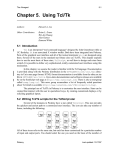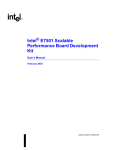Download Intel Xeon® processor 64-bit
Transcript
Product Brief Intel® Xeon® Processor with 2MB L2 Cache The 64-bit Intel Xeon Processor with 2MB L2 Cache ® ® The platform of choice keeps getting better with the 64-bit Intel® Xeon processor with 2MB L2 cache. ® The flexibility to meet your diverse enterprise platform needs. 64-bit Intel® Xeon® processor-based server and workstation platforms are a key to business advantage. They give you the freedom to put more focus on your business with proven technology. You can do more than ever before with ongoing platform innovations. They help you achieve greater flexibility and lower costs with optimized solutions. For dual processor (DP) servers, the 64-bit Intel Xeon processor with 2MB L2 cache gives you the versatility and cost-effectiveness you need for your enterprise front-end server, small/medium business (SMB), large business, or high-performance computing (HPC) needs. For DP workstations, the 64-bit Intel Xeon processor benefits expert users who require expanded performance for data-intensive interactive applications. Choose the 64-bit Intel Xeon processor that’s right for you. 64-bit Intel Xeon processors offer speeds of 2.80 GHz, 3 GHz, 3.20 GHz, 3.40 GHz, 3.60 HGz, and 3.80 GHz. As well, there are new power-optimized 3 GHz LV (55W) and 3.20 GHz MV (90W) options, so you can get just the power you need. The improved efficiency and utilization of these options lets you optimize density (up to 57% improvement), power efficiency (up to 24% energy savings), and cost. Make the transition to 64-bit computing now with 64-bit Intel® Xeon® processor-based servers and workstations. There are compelling reasons to move your business to 64-bit computing now. 64-bit computing with Intel Xeon processor gives you application headroom, I/O headroom, improved reliability, lower power consumption, memory flexibility, and increased security. Now with speeds up to 3.80 GHz, the 64-bit Intel Xeon processor with 2MB L2 cache delivers up to 18%1 higher performance than the previous Intel Xeon processor with 800 MHz system bus and 1MB L2 cache. For DP workstations, performance gain is up to 15%.2 The second processor delivers up to a 93%3 boost in performance in 64-bit Intel Xeon processor-based platforms. The 64-bit Intel Xeon processor gives you the flexibility to prepare for the future. By supporting larger data sets and both 32- and 64-bit applications, 64-bit Intel Xeon processor-based servers and workstations allow the smooth migration of your business solutions to 64-bit applications. And with over six million 64-bit processors already shipped, you know you can depend on Intel’s proven track record to help you make a smooth transition to the next generation of computing. The Platform of Choice Just Got Better Enable Growth Lower Cost Larger Cache SSE3 Demand-Based Switching DDR2 Memory Hyper-Threading Technology PCI Express* Low/Mid Power Processing Intel® EM64T Platform Compatibility RAID Execute Disable Bit Platform Validation RAS Features Mitigate Risk Products and technologies designed and validated together to deliver greater business benefits. The performance, reliability, and flexibility customers demand The 64-bit Intel Xeon processor with 2MB L2 cache delivers enhanced platform performance and dependability through a variety of innovative technologies that include the following: • Get faster response times with double the L2 cache, 2MB, as • compared to the previous generation of Intel Xeon processors. • for server applications and help improve workstation acoustics by using Demand-Based Switching (DBS) with Enhanced Intel Intel® Extended Memory 64 Technology (Intel® EM64T)4 provides SpeedStep® technology. application flexibility with support for 64-bit computing. • Increased performance, with up to 5% increase when using the • Optimize Performance per Watt with low- and mid-power processors. 64-bit Intel® Xeon® processor LV provides the serial interconnects. • to DDR 333. 64-bit Intel® Xeon® processor MV is a rack-optimized solution blade configurations. DDR2-400 memory-based subsystem provides increased memory bandwidth and lower power consumption compared highest performance density for 1U and blade configurations. that provides balanced performance and density for 1U and Scalable bandwidth with PCI Express*, a new I/O technology that matches the performance and capabilities of next generation new 3.80 GHz processor • Take advantage of power savings and increased system density • Help prevent certain classes of malicious “buffer overflow” and worm attacks with Intel’s Execute Disable Bit functionality. Target Applications or Usages: Servers There are many reasons why dual processor servers based on 64-bit Intel Xeon processor are the most widely deployed server in the world. But the biggest one might simply be this: 64-bit Intel Xeon processor-based servers can do virtually anything business demands of it, worry-free. Servers based on the 64-bit Intel Xeon processor with 2MB L2 cache offer compelling value for various applications such as Web caching, multi-user applications, small/medium business, high-performance computing, and more. Server Type Application Category Front-end servers, Internet infrastructure Cache/Web Microsoft ISS*, Apache Directory Microsoft Active Directory* Security infrastructure RSA BSAFE*/SSL-C*, Symantec Norton AV*/ Enterprise Firewall*, Microsoft Crypto Library*, Network Associates, McAfee, Verisign PKI* Messaging (small business and departmental) Lotus Notes*, Microsoft Exchange* e-Commerce, e-Business, Customer Relationship Management (CRM) Adobe Altercast*, Ariba Buyer*, CA CleyerPath*, Interwoven TeamSite*, Microsoft Commerce Server*, Pivotal, Reuters Plus*, SunGard AddVantage* Application servers Application Software Examples Collaboration PTC Windchill*, UGS Teamcenter*, Microsoft Exchange Server* Enterprise management System management, Storage management Veritas ServPoint*, BMC Patrol* Databases Database (small-business and departmental data) Microsoft SQL Server* High-performance computing Clustering OSCAR*, SCYLD*, SCore* Target Applications or Usages: Workstations Dual processor workstations based on the 64-bit Intel Xeon processor with 2MB L2 cache are ideal for today’s high-performing single-user needs in areas such as computer aided engineering (CAE) and drafting, electronic design automation, digital media, financial analysis, oil/gas exploration, and software engineering. With large cache size and Intel® Hyper-Threading Technology5 designed specifically for multitasking environments, Intel Xeon processor-based workstations provide outstanding performance for multi-threaded applications. 64-bit Intel Xeon processor-based workstations support a broad range of 32- and 64-bit applications and are designed to handle large data sets, increased memory, and fast I/O with the support of advanced technologies like DDR2 memory and PCI Express. Application Category Application Software Examples ASIC design Design Compiler*, Calibre*, Verilog-XL*, VCS*, ModelSim*, SeedSim*, QuickSim*, TeraForm*, IC Station*, Seamless*, Celaro*, LeonardoSpectrum* Compositing/effects Avid*/Softimage*, Discreet*, Adobe, Nothing Real* Custom IC CAD Si/Gate Ensemble*, Dracula*, Hercules*, Blast*, Grandmaster*, Dolphin*, EPIC Tools* Digital content creation Toxik*, 3D Studio Max*, Renderman*, Socratto*, Lightwave Maya* FPGA and PLD creation Accel*, Design Book*, Altera Quartus*, Protel*, Summit*, Minc*, FPGA Express* Life sciences CHARMm*, Blast*, d2_Cluster*, DGauss* Mechanical CAD Pro/Engineer*, Parasolid*, Unigraphics* Mechanical CAE Pam Crash*, Abaqus*, LS-Dyna*, Nastran*, Permas*, Multiphysics* Non-linear video editing Avid*, Discreet*, Adobe, NewTek Printed circuit board design Boardstation*, Allegro* (Spectra), Interconnect Synthesis*, Viewlogic*, P-Cad*, OrCad*, Veribest* 3D modeling/animation Alias/Wavefront*, Avid*/Softimage*, 3D Studio Max*, NewTek 3D network rendering Mental Images*, Pixar*, Blue Moon*, Play-Electric Image* The Value of 2MB L2 Cache 64-bit Intel Xeon Process or with 2MB L2 Cache ® ® 64-bit Intel® Xeon® processor 3.60 GHz with 2MB L2 cache performance gains over 64-bit Intel® Xeon® processor 3.60 GHz with 1MB L2 cache. Server Workstation SPECint*_rate_base2000 1.18 (Est.) SPECfp*_rate_base2000 SPECfp*_rate_base2000 1.17 (Est.) Ansys* 9 – PCG solvers SPECjbb2000 1.12 SPECint*_rate_base2000 WebBench 1.11 MSC.Nastran* 2004 – xxafst2 Star-CD 1.10 3ds max* 6.1 – “aBathroom” render 0.0 0.2 0.4 0.6 0.8 1.0 1.2 1.4 1.6 1.15 (Est.) 1.14 1.13 (Est.) 1.13 1.05 0.0 0.2 0.4 0.6 0.8 1.0 1.2 Up to an additional 5% performance improvement with 64-bit Intel® Xeon® processor 3.80 GHz8. 1.4 DP Server/HPC Configuration: SPECint_rate_base2000, SPECfp_rate_base2000 – Intel® S3E1322 Server System (BIOS CYCRB043) with two 64-bit Intel® Xeon® processors 3.60 GHz with 2MB L2 Cache, 800 MHz FSB; 8 GB DDR2-400 memory; Hyper-Threading OFF; Red Hat* Enterprise* Linux 3, update3, 64bit, 2.4 kernel. 8.1 binaries for SPECcpu2000; (Disclaimer: SPECint2000 and SPECfp2000 benchmark tests reflect the performance of the microprocessor, memory architecture and compiler of a computer system on compute-intensive, 32-bit applications. SPEC benchmark tests results for Intel microprocessors are determined using particular, well-configured systems. These results may or may not reflect the relative performance of Intel microprocessor in systems with different hardware or software designs or configurations (including compilers). Buyers should consult other sources of information, including system benchmarks; to evaluate the performance of systems they are considering purchasing.) SPECjbb2000 – Veritest Labs – Intel® Server Board SE7520JR2 with Intel® E7520 chipset; Dual processor configuration with 64-bit Intel® Xeon® processor 3.60 GHz with 2MB L2 cache, 800 MHz FSB; 4 GB DDR2-400 memory; Hyper-Threading ON, Microsoft Windows* 2000, BEA WebLogic JRockit* 8.1 Service Pack 2 Java Virtual Machine (JVM). WebBench – Veritest Labs – Intel® Server Board SE7520JR2 with Intel® E7520 chipset; Dual processor configuration with 64-bit Intel® Xeon® processor 3.60 GHz with 2MB L2 cache, 800 MHz FSB; 4 GB DDR2-400 memory; 2 Intel® PRO/1000 Gigabit Server adapter; Hyper Threading ON; Microsoft Windows* 2003. Star-CD (ver. 3.150A) – Intel® S3E1322 Server System (BIOS CYCRB043) with two 64-bit Intel® Xeon® processors 3.60 GHz with 2MB L2 Cache, 800 MHz FSB; 8 GB DDR2-400 memory; Hyper-Threading OFF; Red Hat* Enterprise* Linux 3, update3, 64bit, 2.4 kernel. DP Workstation Configuration: SPECfp_rate_base2000 and SPECint_rate_base2000 using Intel Compiler 8.1 binaries (August 2004). (Disclaimer: SPECint2000 and SPECfp2000 benchmark tests reflect the performance of the microprocessor, memory architecture and compiler of a computer system on compute-intensive, 32-bit applications. SPEC benchmark tests results for Intel microprocessors are determined using particular, well-configured systems. These results may or may not reflect the relative performance of Intel microprocessor in systems with different hardware or software designs or configurations (including compilers). Buyers should consult other sources of information, including system benchmarks; to evaluate the performance of systems they are considering purchasing.) Ansys standard workloads using elapsed time geometric mean of three “PCG” solvers available at FTP site. “brakerotor_small_structural,” “brakerotor_small_thermal,” and “carrier_pcg_small.” MSC.Nastran deck “xxafst” using solver 101. Median of three runs used for calculations. 3ds max rendering “aBathroom” scene using default settings. Median of three renders used for calculations. *HT enabled for these benchmarks. SYSTEM CONFIGURATIONS: COMMON: 36GB SCSI Seagate* ST336753LW 15K hard drive, Microsoft Windows* XP Professional SP1 – NTFS. Intel® Xeon® processor with 800 MHz system bus-based workstation at 3.60 GHz (**2P unless noted) Intel WS400 internal E7525 chipset-based reference board, BIOS 38 HT disabled*, 4GB DDR2-400 – 8x 512MB Samsung* M393T6553BG0-CCC, Adaptec* AIC7902 Ultra320 SCSI adapter, Intel Chipset Software Utility INF version 6.01.1002, nVidia* Quadro* FX 1300 128MB PCIe video card using driver 61.60. Intel® Xeon® processor with 2MB L2 cache at 3.60 GHz Intel WS400 internal E7525 chipset-based reference board, BIOS 43 HT disabled,* 4GB DDR2-400 – 8 x 512MB Samsung* M393T6553BG0-CCC, Adaptec* AIC7902 Ultra320 SCSI adapter, Intel Chipset Software Utility INF version 6.01.1002, nVidia* Quadro* FX 1300 128MB PCIe video card using driver 65.73. Improved Performance per Rack with Power-Optimized Platform Intel Xeon Process or LV 3 GHz ® ® Aggregate Performance per 6kW Rack 100% 3.60 GHz SPECint_rate/Rack 119% LV/3 GHz 19% performance/rack increase 100% 3.60 GHz SPECfp_rate/Rack 124% LV/3 GHz 0 20 40 60 80 24% performance/rack increase 100 120 140% Performance: published results from spec.org as of 8/24/2005; Irwindale 3.6 GHz of 40.8 and 33.2 and Irwindale 3 GHz of 34.6 and 29.5 for SPECint_rate and SPECfp_rate respectively. System Power: Maximum power calculated based on 2xprocessors, 4 GB DDR2-400 memory, 75% efficiency power supply; Irwindale 3.6 GHz of 557 watts, LV Irwindale of 410 watts. Performance tests and ratings are measured using specific computer systems and/or components and reflect the approximate performance of Intel products as measured by those tests. Any difference in system hardware or software design or configuration may affect actual performance. Buyers should consult other sources of information to evaluate the performance of systems or components they are considering purchasing. For more information on performance tests and on the performance of Intel products, visit http://www.intel.com/performance/resources/limits.htm or call (U.S.) 1-800-628-8686 or 1-916-356-3104. 64-bit Intel® Xeon® Processor with 2MB L2 Cache Overview DP servers and workstations based on the 64-bit Intel Xeon processor with 2MB L2 cache help deliver performance, reliability, versatility, and low ownership costs and more, at a variety of price-points. The performance charts illustrate the advantages of the Intel Xeon processor with 2MB L2 cache. Features Benefits 2MB integrated L2 cache More data can be stored closer to processor execution units for faster data access, resulting in higher system throughput and shorter system latency Intel® Extended Memory 64 Technology (Intel® EM64T)4 Enhances next-generation IA-32 platforms with 64-bit addressability and related instructions, allowing flexibility for 64-bit and 32-bit applications and operating systems Demand-Based Switching (DBS) with Enhanced Intel SpeedStep® technology Helps reduce average system power consumption and potentially improves system acoustics Streaming SIMD Extensions 3 (SSE3) instructions Better multimedia and encryption/decryption processing, along with support for more computationally intensive graphics Hyper-Threading Technology Improves processor utilization and system responsiveness in conjunction with the new Streaming SIMD 3 instructions for better user experience compared to previous generation 5 800 MHz system bus Provides greater platform bandwidth than previous generation for increased memory (with DDR2-400 memory), PCI Express* I/O and graphics Multiple versions available up to 3.80 GHz Broad family offering brings performance enhancements across multiple price points Platform Solutions The following chipsets are optimized for the 64-bit Intel Xeon processor with 2MB L2 cache family. They support DP-based platforms by delivering increased system bus, memory, and I/O bandwidth for enhanced performance, scalability, and end-user productivity compared to previous generation. DP server-supported chipsets: • • DP workstation-supported chipset: Intel® E7520 chipset: For performance and volume server platforms. Intel® E7525 chipset: For performance and volume workstation Full feature support includes three configurable PCI Express x8 links. platforms. Full feature support includes one configurable PCI Intel® E7320 chipset: For value platforms. Includes one configurable Express x8 link and one configurable PCI Express x16 link for PCI Express x8 link. • • graphics support. These platform configurations provide flexibility for multiple segments Note: The Intel® IOP332 I/O processor can be integrated in DP and headroom for future growth, allowing tailored solutions for today’s server platforms to create high-performance, cost-effective, on- enterprise environment while helping to protect your investment in board intelligent RAID solutions for increased I/O performance design, integration, and support. and reliability. Intel® Xeon® Processor Feature Set Reference Table Processor Speed Processor Name Processor Thermal Design Power (Watts) Cache Size HyperThreading Technology 64-bit Computing DemandBased Switching Execute Disable Bit Process Functionality Technology 64-bit Intel® Xeon® processor 3.80 GHz with 2MB L2 Cache 3.80 GHz 110W 2MB L2 • • • • 90 nm 64-bit Intel Xeon processor 3.60 GHz with 2MB L2 Cache 3.60 GHz 110W 2MB L2 • • • • 90 nm 64-bit Intel® Xeon® processor 3.40 GHz with 2MB L2 Cache 3.40 GHz 110W 2MB L2 • • • • 90 nm 64-bit Intel® Xeon® processor 3.20 GHz with 2MB L2 Cache 3.20 GHz 110W 2MB L2 • • • 90 nm 90 nm ® ® 64-bit Intel Xeon processor 3 GHz with 2MB L2 Cache ® ® 64-bit Intel® Xeon® processor 2.80 GHz with 2MB L2 Cache 64-bit Intel® Xeon® processor LV 3 GHz 64-bit Intel® Xeon® processor MV 3.20 GHz 3 GHz 110W 2MB L2 • • • 2.80 GHz 110W 2MB L2 • • • 90 nm 3 GHz 55W 2MB L2 • • • 90 nm 3.20 GHz 90W 2MB L2 • • • 90 nm • Find out more about 64-bit Intel® Xeon® processor at www.intel.com/products/server/processors/server/xeon/ 1 SPECint_rate_base2000 – Intel® Corporation internal measurements; data as of January 2005. Intel® S3E1322 Server System (BIOS CYCRB043) with two 64-bit Intel® Xeon® processors 3.60 GHz with 2MB L2 Cache, 800 MHz FSB; 8 GB DDR2-400 memory; Hyper-Threading OFF; Red Hat* Enterprise* Linux 3, update3, 64bit, 2.4 kernel. 8.1 binaries for SPECcpu2000; (Disclaimer: SPECint2000 benchmark tests reflect the performance of the microprocessor, memory architecture and compiler of a computer system on compute-intensive, 32-bit applications. SPEC benchmark tests results for Intel microprocessors are determined using particular, well-configured systems. These results may or may not reflect the relative performance of Intel microprocessor in systems with different hardware or software designs or configurations (including compilers). Buyers should consult other sources of information, including system benchmarks; to evaluate the performance of systems they are considering purchasing.) 2 SPECfp*_ rate_base2000 – Intel® Corporation internal measurements; data as of January 2005. SPECfp_rate_base2000 using Intel Compiler 8.1 binaries (August 2004). (Disclaimer: SPECfp2000 benchmark tests reflect the performance of the microprocessor, memory architecture and compiler of a computer system on compute-intensive, 32-bit applications. SPEC benchmark tests results for Intel microprocessors are determined using particular, well-configured systems. These results may or may not reflect the relative performance of Intel microprocessor in systems with different hardware or software designs or configurations (including compilers). Buyers should consult other sources of information, including system benchmarks; to evaluate the performance of systems they are considering purchasing.) 3 Server: SPECjbb2000 – Veritest measurement – Intel® Server Board SE7520JR2 with Intel® E7520 chipset; One and two processor configuration with 64-bit Intel® Xeon® processor 3.60 GHz with 2MB L2 cache, 800 MHz FSB; 4 GB DDR2-400 memory; Hyper Threading ON, Microsoft Windows* 2000, BEA WebLogic JRockit* 8.1 Service Pack 2 Java Virtual Machine (JVM). Workstation: SPECint_rate_base2000 – Intel® Xeon® processor with 800 MHz system bus-based workstation at 3.60 GHz Intel WS400 internal E7525 chipset-based reference board, BIOS 38 HT disabled*, 4GB DDR2-400 – 8 x 512MB Samsung* M393T6553BG0-CCC, Adaptec* AIC7902 Ultra320 SCSI adapter, Intel Chipset Software Utility INF version 6.01.1002, nVidia* Quadro* FX 1300 128MB PCIe video card using driver 61.60 Intel Compiler 8.1 binaries for SPECcpu2000. 4 Intel® EM64T requires a computer system with a processor, chipset, BIOS, OS, device drivers and applications enabled for Intel EM64T. Processor will not operate (including 32-bit operation) without an Intel EM64T-enabled BIOS. Performance will vary depending on your hardware and software configurations. Intel EM64T-enabled OS, BIOS, device drivers and applications may not be available. Check with your vendor for more information. 5 Hyper-Threading Technology requires a computer system with an Intel® Pentium® 4 processor supporting Hyper-Threading Technology and an HT Technology-enabled chipset, BIOS and operating system. Performance will vary depending on the specific hardware and software you use. See http://www.intel.com/info/hyperthreading/ for more information including details on which processors support HT Technology. 6 5% gain based on Intel internal measurement on Specint_base2000 benchmark. Both baseline and new measurement estimation done on Intel® S3E1323 Server System (Coyote) BIOS: AMIBIOS 08.00.10, build 06/10/05, ID: CYMOD051; Memory: 8 GB (8 x 1GB DDR2-400) E7520 Chipset. Prefetch setting: Default; OS: Microsoft Windows* Server 2003 Enterprise Edition; SPECCPU2000 benchmark version 1.2; Binaries produced with Intel® C/C++ and FORTRAN Compilers version 9.0 (Build 20050521); Microsoft* Visual Studio* .NET (VC2002) for include and library files. Baseline Processor: 64-bit Intel® Xeon® Processor 3.60 GHz/2MB L2 cache; New Processor: 64-bit Intel Xeon Processor 3.80 GHz/2MB L2 cache. INFORMATION IN THIS DOCUMENT IS PROVIDED IN CONNECTION WITH INTEL PRODUCTS. NO LICENSE, EXPRESS OR IMPLIED, BY ESTOPPEL OR OTHERWISE, TO ANY INTELLECTUAL PROPERTY RIGHTS IS GRANTED BY THIS DOCUMENT. EXCEPT AS PROVIDED IN INTEL’S TERMS AND CONDITIONS OF SALE FOR SUCH PRODUCTS, INTEL ASSUMES NO LIABILITY WHATSOEVER, AND INTEL DISCLAIMS ANY EXPRESS OR IMPLIED WARRANTY, RELATING TO SALE AND/OR USE OF INTEL PRODUCTS INCLUDING LIABILITY OR WARRANTIES RELATING TO FITNESS FOR A PARTICULAR PURPOSE, MERCHANTABILITY, OR INFRINGEMENT OF ANY PATENT, COPYRIGHT OR OTHER INTELLECTUAL PROPERTY RIGHT. Intel products are not intended for use in medical, life saving, or life sustaining applications. Intel may make changes to specifications and product descriptions at any time, without notice. *Other names and brands may be claimed as the property of others. Copyright © 2005 Intel Corporation. All rights reserved. Intel, the Intel logo, Intel Xeon, Intel SpeedStep, and the Intel Inside logo are trademarks or registered trademarks of Intel Corporation or its subsidiaries in the United States and other countries. Printed in USA 0905/GJA/OCG/PP/2.5K Please Recycle 306385-002US
















